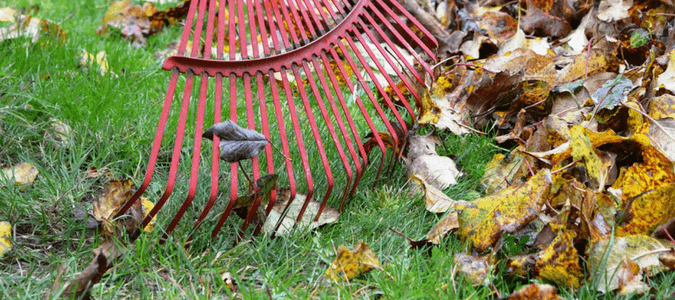
Newcomers to Texas and other parts of the country where oaks are prevalent are surprised to learn that these stately trees lose their leaves in the spring rather than during the fall. While oaks give us wonderful shade from the intense sun, they do give us lots of other things during the year: leaves.
No matter how long you’ve had oak trees, if you’re like a lot of people, you’re probably not a huge fan of having dead leaves cover that beautiful lawn you’ve spent so much time on. Moreover, you might have heard that oak leaves are acidic and worry they will damage your grass or soil if you don’t get rid of them quickly.
In the past, you may have simply raked up the leaves and put them in bags. Is there a better solution?
In fact, there is not only a better solution, but several options. Most of them come down to using the leaves instead of having them hauled away.
Before we dive into that, though, let’s talk about a fear that may be gnawing at you: the acidity of fallen oak leaves and the possibility of it hurting your lawn.
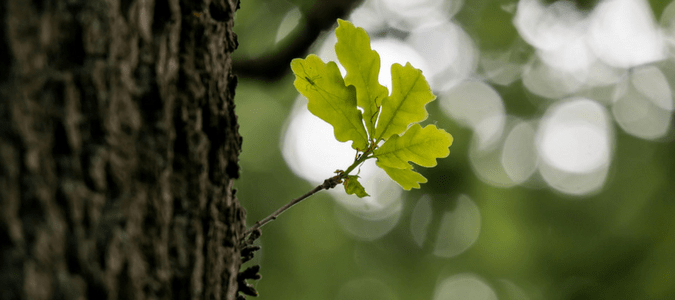
Are Oak Leaves Acidic?
There’s a short answer to this question and a long one. The short answer is that, yes, oak leaves are acidic. Before you run out to your yard to clear them away, though, let us explain a bit further.
When oak leaves are fresh, they possess a pH level of around 4.5 to 4.7, making them acidic. However, as they break down, they get much closer to neutral. The bottom line is that multiple studies have shown that oak leaves (even in large quantities) have no effect on the acidity of soil.
What oak leaves do have is nutritional value that will be transferred to your soil as the leaves decay. What kind of nutritional value? Well, for example, research has found that leaves can contain as much nitrogen as cow manure that has been composted for use as an organic fertilizer…and it smells a lot better, too!
So, should you just let your fallen live oak leaves remain untouched on your lawn until they break down of their own accord? You can. Unlike some other types of leaves, live oak leaves are unlikely to prevent your lawn from “breathing,” encourage disease or serve as an open invitation to insect pests. Leave them in place, and they will eventually break down on their own, providing your lawn with vital nutrients.
Unfortunately, “eventually” can be a long time for live oak leaves. What if you just can’t stand the sight of all those leaves mucking up your gorgeous lawn?
Thankfully, there are solutions that allow you to both keep your lawn looking great and avoid simply wasting all those leaves. Two great options are mulching and composting.
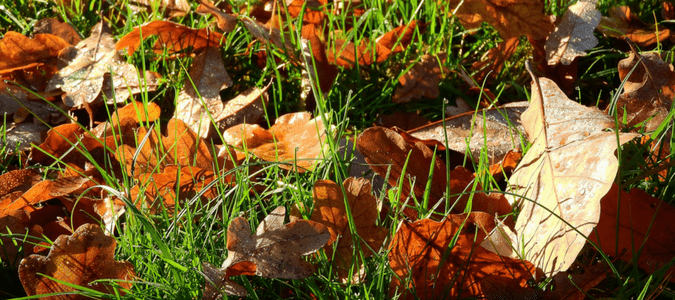
Mulching Oak Leaves on Your Lawn: What You Should Know
What exactly does it mean to mulch leaves? At the most basic level, mulching leaves means cutting or breaking them up, so you can spread the pieces either over your grass or into flower or vegetable beds.
Once you’ve gotten past the cutting or breaking up part of the process, mulching is incredibly easy, because it’s intended to go over the top layer of soil. You really do just spread the leaves out and let them sit there.
Unfortunately, you can’t just skip over the actual mulching part of mulching. And as anyone with live oak trees knows, the leaves are pretty tough, unlike other, more brittle leaves belonging to other tree species.
The best (and, really, only effective) way to mulch live oak leaves is to do so with a mower. Ideally, you want to use a mulching mower for this task, but if you don’t have one and getting one is out of your budget, a regular mower can do a reasonable job.
A nice middle ground may be to see if you can purchase a mulching blade for your current mower. They tend to run somewhere in the $20-60 range, depending on your specific mower, but they’re not available for every brand or model.
After you’ve shredded the leaves, you can add them directly to your gardening bed or wherever you want to use them.
Composting is a bit more complicated, but may be worth it, due to the added benefits. What’s the best way to compost live oak leaves?
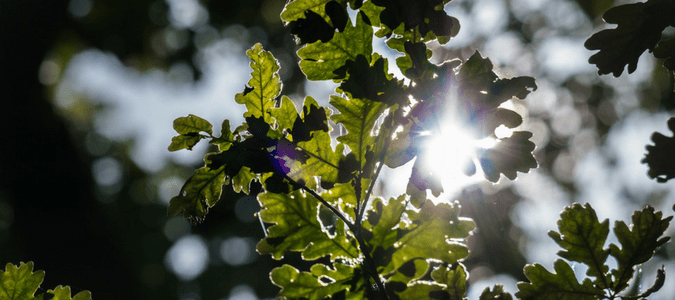
Composting Live Oak Leaves: Step-By-Step Instructions
Live oaks are one of several oak tree species which does well in Texas and other southern states. If you want to compost these leaves, here are the steps to consider:
- Make sure you’re okay with having a compost pile. This may seem obvious, but composting means having a compost pile. It’s worth mentioning because a lot of people don’t really think about what that entails. Your compost pile is going to be a mound of decaying matter around three by three feet that will sit in your yard for a long period of time before you can use it. Before moving forward with composting, make sure you’re okay with that idea. Another consideration that we have to mention is that compost piles can attract pests that feed on organic matter, which can include roaches and rodents.
- Select the location for your compost pile. Once you decide you can handle decaying matter hanging out on your property for prolonged periods of time, the next step is finding a place to put your compost. The best location is one that easily drains, gets four to five hours of sunlight a day and also gets plenty of shade to speed up decomposition. Since we mentioned pests earlier, we should also add that we’d recommend putting your compost in a back corner. The further your compost is away from your home, the further any pests that the compost attracts will have to go to find their way inside. The trade-off here is that if you choose to add kitchen waste to the compost, it will mean walking that much further to empty your kitchen container—but trust us, it’s worth it.
- Get out the rake. You knew this was coming, right? Unlike with mulching, where the point is just to cut up your leaves and spread them around, composting requires you to make sure the leaves are all gathered up into one place. Which means raking.
- Shred away. Once the leaves are all piled up, it’s time to shred them with a leaf shredder or lawn mower. We recommend using a lawn mower with an attached bag, so you don’t have the extra steps of gathering up the shredded leaves and putting them in a garbage bag. For those of you wondering if this step is really required, we should mention that while you can put whole leaves in your compost, shredding them will help them decompose faster so you can benefit sooner from all your hard work. Shredded leaves will also take up less room in your compost.
- Make your compost pile. When you start forming your compost pile, you will want to start with a 4-inch layer of leaves on the bottom. Next, you should add about an inch of some kind of organic material. Good options include bovine manure, existing compost, grass clippings or green weeds. Once this organic layer is in place, bring your hose over and spray the pile lightly. If you have more leaves to compost, repeat the process. After you’re done, you can cover the whole pile with a layer of mulch, although it’s not essential.
- Mix and aerate. To encourage decomposition, you will need to use a rake or pitchfork to basically “mix” the compost pile regularly to incorporate oxygen. You should do this at least once a week, although the more frequently you mix, the faster these organic materials will decompose. Continue to spray your compost pile lightly with water as well.
- Playing the waiting game. You will need to continue the above processes and wait until the pile turns dark brown and crumbly and starts to smell earthy. At that point, it is finally ready to use as compost.
If that sounds like a lot of work, it is. Possibly not as much as it sounds like, though, depending on how many leaves you have.
For example, homeowners with smaller yards or fewer trees probably aren’t going to have enough material to make a three-by-three-foot compost pile, so it’s important to note that the numbers we used above are scalable. Generally speaking, you want your pile to be as wide as it is tall, meaning a one-foot high mound of compost only needs to be a foot wide.
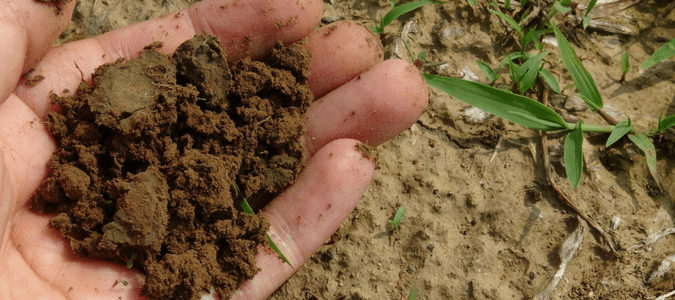
Benefits of Composting Oak Leaves
What are some of the benefits of composting oak leaves? Why go to all the trouble?
There are many good reasons to compost oak leaves, just like any other organic matter, whether you’re concerned about the environment, your landscape, or your wallet.
Reducing Waste
Composting can reduce your waste by up to 50 percent. Want to throw away less? Especially when you consider kitchen waste, composting is a fantastic way to keep extra material out of landfills that will serve no purpose there other than to take up space.
Less Need For Fertilizer
Tired of using (and paying for) fertilizers? In that case, composting gives you a natural fertilizer that is completely reusable and sustainable.
Addition of Beneficial Micro-Organisms To Your Soil
Adding compost to your soil will encourage it to produce micro-organisms that not only enrich soil that’s already doing fine, but also help poor soil to regenerate.
Healthy Root Development
When there’s a higher amount of organic matter in your soil, it retains moisture better, releasing it more slowly over a longer period. Roots love to grow in this type of soil.
Improved Pest And Disease Resistance
Something else those micro-organisms do? Keep out pests and suppress diseases.
Increased Production
As anyone with a green thumb knows, the better your soil, the better your crops will be.
Reduced Toxins
Soil rich from compost can degrade or eliminate all kinds of hazardous materials.
Less Erosion
Adding in compost is particularly valuable on roadsides, in hilly areas and on lawns where children play to reduce run-off.
ABC Can Keep Your Trees And Lawn Healthy
Composting oak leaves isn’t an easy job, nor is removing them from your yard, especially if you are allergic to oak pollen, which often peaks right around the time leaves are falling. These towering giants also require specialized care that many homeowners don’t have the time to administer. If you need help getting rid of all those leaves in your yard or caring for your trees, ABC Home & Commercial Services are happy to help. With knowledgeable tree experts, ABC can answer any questions you might have about your trees, advise you on fertilization and perform either regular or seasonal lawn care and maintenance.
